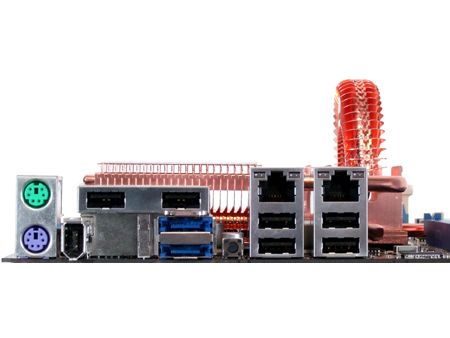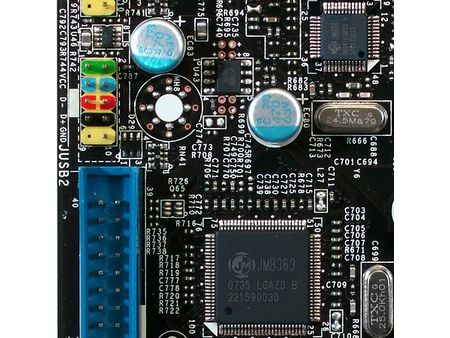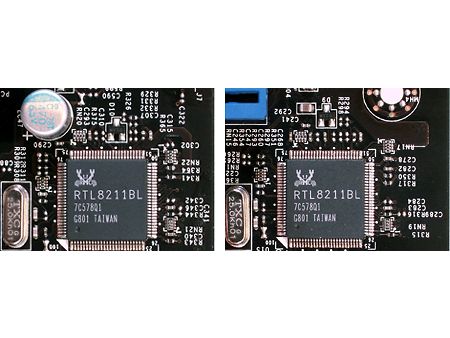790i Ultra SLI Motherboards Compared
Onboard Devices
| Northbridge | Nvidia nForce 790i Ultra SLI SPP |
| Southbridge | Nvidia nForce 790i Ultra SLI MCP |
| Voltage Regulator | Eight Phases |
| BIOS | V25.0B3 (05/28/2008) |
| 333.3 MHz (FSB-1333) | 333.3 MHz (+0.0%) |
| Clock Generator | Nvidia |
| Connectors and Interfaces | Row 6 - Cell 1 |
| Onboard | 2x PCIe 2.0 x16 (Full Bandwidth) |
| Row 8 - Cell 0 | 2x PCIe x16 (Modes: 1x 16, 1x 8) |
| Row 9 - Cell 0 | 2x PCIe x1 |
| Row 10 - Cell 0 | 1x PCI |
| Row 11 - Cell 0 | 2x USB 2.0 (2 ports per connector) |
| Row 12 - Cell 0 | 1x IEEE-1394 FireWire |
| Row 13 - Cell 0 | 1x Serial Port header |
| Row 14 - Cell 0 | 2x Ultra ATA (2 drives per connector) |
| Row 15 - Cell 0 | 6x Serial ATA 3.0 Gb/s |
| Row 16 - Cell 0 | 1x Fan 4 pins (CPU/Chassis) |
| Row 17 - Cell 0 | 4x Fan 3 pins (Chassis/Chipset) |
| Row 18 - Cell 0 | 1x Internal Power Button |
| Row 19 - Cell 0 | 1x Internal Reset Button |
| IO panel | 2x PS2 (keyboard + mouse ) |
| Row 21 - Cell 0 | 6x USB 2.0 |
| Row 22 - Cell 0 | 1x IEEE-1394 FireWire |
| Row 23 - Cell 0 | 2x External SATA |
| Row 24 - Cell 0 | CLR_CMOS Button |
| Row 25 - Cell 0 | 2x RJ-45 Network |
| Mass Storage Controllers | Row 26 - Cell 1 |
| nForce 790i MCP | 6x SATA 3.0 Gb/s (RAID 0, 1, 0+1, 5, JBOD) |
| JMicron JMB363 PCI-E | 1x Ultra ATA-100 (2-drives) |
| Row 29 - Cell 0 | 2x SATA 3.0 Gb/s (RAID 0,1, JBOD) |
| Network | Row 30 - Cell 1 |
| 2x Realtek RTL8211BL PHY | 2x Gigabit LAN Connection |
| Audio | Row 32 - Cell 1 |
| Creative X-Fi Xtreme Audio Card | 7.1 channel digital/analog output |
| FireWire | Row 34 - Cell 1 |
| JMicron JMB381 PCI-E | 2x IEEE-1394a (400 Mbit/s) |
MSI provides most of the onboard features one would expect of top-level parts, but goes a step farther by skipping the audio codec and instead including a PCI Express discrete sound card. It’s not a huge step, of course, as this is the most modest of Creative’s X-Fi products.
Because the included sound card has its own digital signal, MSI makes no use of the chipset’s HD Audio capability. No digital audio outputs are found anywhere on the P7N2 Diamond, neither internally nor on the port panel.
Outdated PS/2 ports supplement the otherwise modern port selection, allowing gamers to keep their favorite keyboard or mouse regardless of age. In addition to the expected six USB 2.0, single IEEE-1394, dual eSATA 3.0 Gb/s, and two Gigabit Network ports, MSI also provides a handy CLR_CMOS switch, just like Asus.
Unlike Asus, we didn’t find any way to disable the CLR_CMOS switch to prevent accidental use. Instead, MSI simply made its button smaller and more difficult to reach. Perhaps a flip-top cover would be a perfect compromise?
MSI is the first company we’ve seen to use a PCI Express IEEE-1394 FireWire controller: the tiny JMB381 seen in the top corner of the photo below. PCI Express isn’t needed for medium-bandwidth devices, but its simpler wiring and reduced mounting space makes sense. The JMB381 FireWire controller is also the same size as the JMB362 SATA controller used by two competing motherboards for eSATA.
The giant JMB363 provides one additional Ultra ATA connection and two eSATA 3.0 Gb/s ports.
Two Realtek RTL8211BL PHYs directly interface to Nvidia’s integrated dual-network controller.
Get Tom's Hardware's best news and in-depth reviews, straight to your inbox.
MSI’s X-Fi Xtreme Audio card has a slightly different port design than Creative’s branded models, but uses the same controller. The card’s top provides the front-panel audio header and internal digital audio output typically found on motherboards.
-
Crashman This was ALL OF THE AVAILABLE 790i Ultra SLI MOTHERBOARDS: Other graphics brands with NVIDIA reference boards INCLUDING EVGA are selling the same unit as XFX, even with the same BIOS (except for the boot logo). XFX was the only one who cared to send one.Reply -
giovanni86 Thats what i was going to say!!! Thank god. Well i guess i made the right choice. XFX 790i, exactly what i am going to buy in the coming month. Just need to save for it XD.Reply -
jaragon13 Who would pay four hundred dollars,when you can just buy a P45 for 100-150 dollars which has roughly the same real world experience as an X48 or 790I?Reply
Nah,I'd rather buy better and more reliable parts-such as power supply,processor,GRAPHICS CARD,and maybe go buy a rifle :P -
kitsilencer $400 for a motherboard? What the hell is wrong with the X48 Express that people would rather consider buying a 790i? And it can't be because of SLI. Makes more sense to buy the X48 and Crossfire.Reply -
Crashman jaragon13Who would pay four hundred dollars,when you can just buy a P45 for 100-150 dollars which has roughly the same real world experience as an X48 or 790I?Nah,I'd rather buy better and more reliable parts-such as power supply,processor,GRAPHICS CARD,and maybe go buy a rifleReply
If you want SLI you're going to need an SLI motherboard. The article specifically stated that the reference design motherboard was almost as good in many ways as the winning board, but far cheaper.
The site only has two awards, one is for top value and the other is for "best of the best". It's hard to award a $350 motherboard for top value, but it's not so difficult awarding the "best of the best" even if the price is outrageous -
Crashman kitsilencer$400 for a motherboard? What the hell is wrong with the X48 Express that people would rather consider buying a 790i? And it can't be because of SLI. Makes more sense to buy the X48 and Crossfire.Reply
It does! Well, sorta. If you want the absolute fastest rig on the planet, you're going to need at least two, possibly three, GTX280's. But if you can wait a few days or maybe a couple weeks, you might be surprised at how well a Crossfire set of HD4870X2's can perform using an X48 motherboard. -
jaragon13 My point is that,even though you could theoritically have 3/4 GPU's all at once,you won't get nearly as much performance as you'd want.A simple 750I or P45 chipset will do nearly the same job.Reply -
zer00000 It is a foxconn board i bet.I just read a review elsewhere with same stuff except it had an x48 chipset."All manner of goodies are bundled with the Black Ops: a 120MM fan, a plastic dry ice cooling pot for the Northbridge, and a Plexiglas "benching table" for open-air use."Reply




